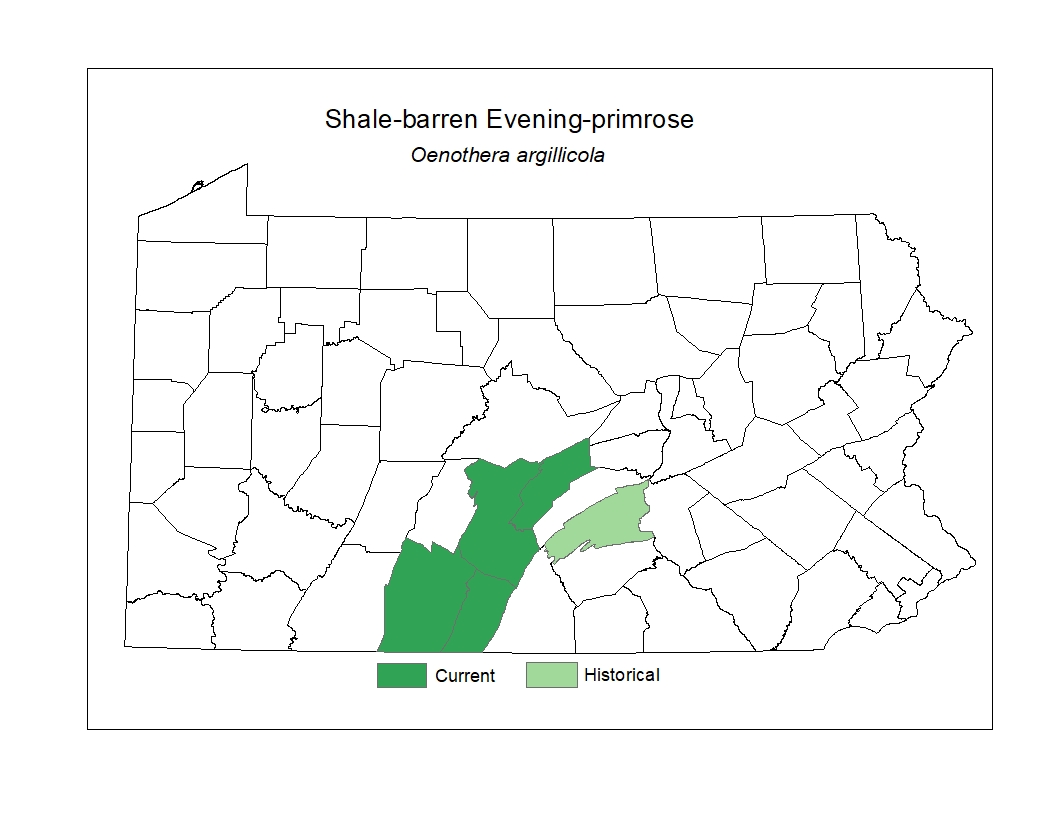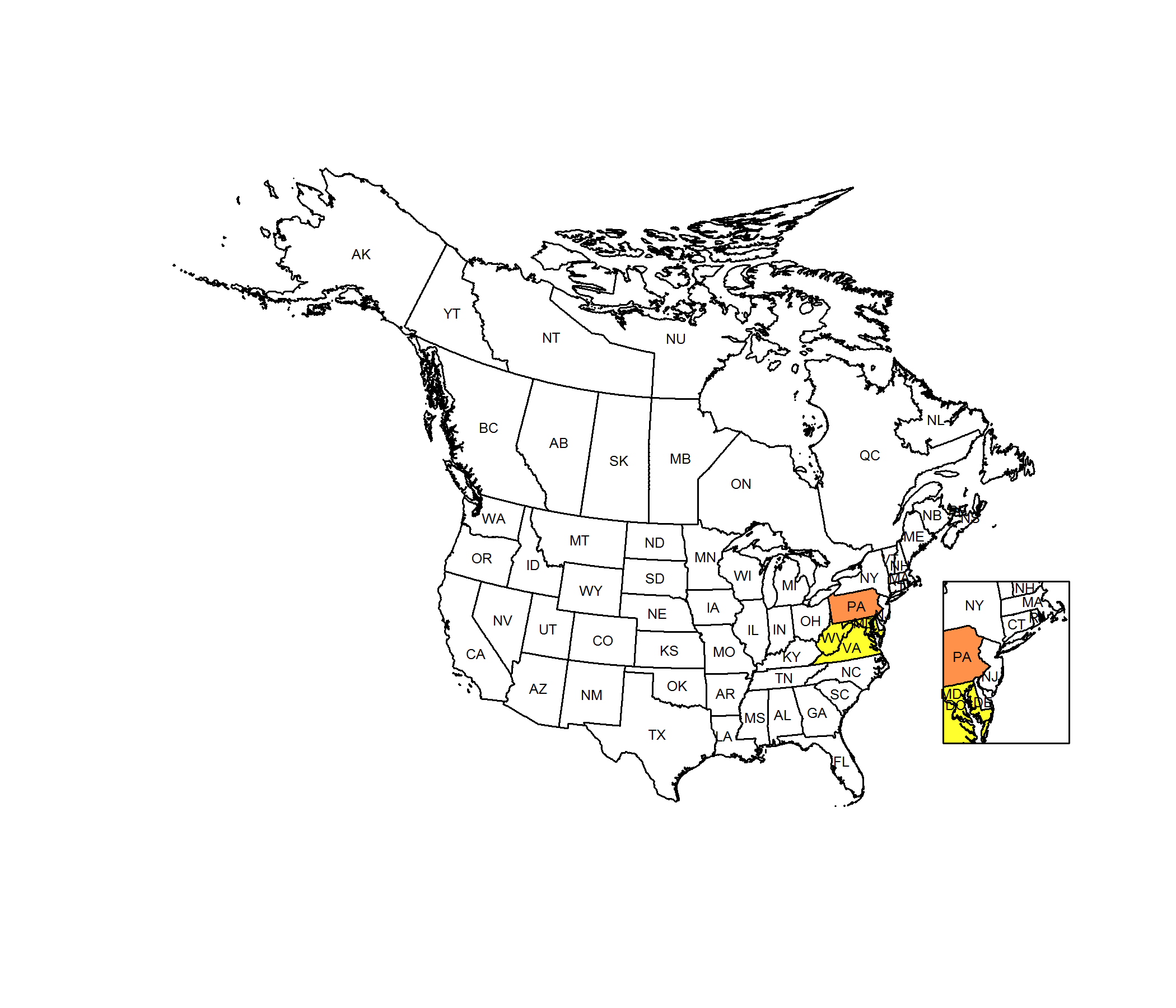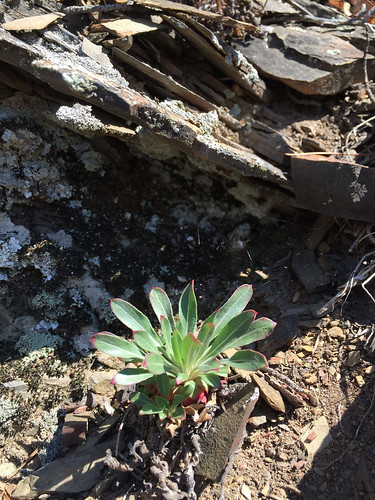 Species Factsheets
Species Factsheets
Oenothera argillicola
Shale-barren Evening-primrose
State Status: Pennsylvania Threatened (PT)
PBS Status: Pennsylvania Threatened (PT)
Federal Status:
Global Rank: G3G4
![]() rank interpretation
rank interpretation
State Rank: S2
Did You Know?
The phenotype of species hybrids in the genus Oenothera aren't compatible with the concept of "pure species" when compared with recognized species, so it is believed most Oenothera are constant hybrids.
Description
Shale-barren evening-primrose (Oenothera argillicola) is a showy biennial herb that can reach 1.5m in hieght. Its erect or ascending stems are smooth and grow from strong, fleshy roots. The leaves grow both basally and alternately along the stem. Stem leaves are narrowly lance-shaped, and up to 1cm wide by 18cm long. Leaves are glossy, dark green and sometimes finely hairy. The flowers are yellow and usually last only one day. Each flower has a round ovary and four overlapping petals that are 2-4cm long. Flowers are displayed from July through September in a spike-like cluster that droops at the top.
Rank Justification
Imperiled in the nation or state because of rarity due to very restricted range, very few populations (often 20 or fewer), steep declines, or other factors making it very vulnerable to extirpation from the nation or state.
PABS
The PA Biological Survey considers the shale-barren evening-primrose to be a species of special concern, based on the relatively few occurrences that have been confirmed and the very specialized habitat. It has been assigned a rarity status of Threatened.
Habitat
The species tends to grow on “shale barrens”, which occur on dry, open, usually steep slopes, banks, and cliffs, with shale substrate, typically on southerly or westerly aspects overlooking streams.
Survey Dates
Flowers July - September
Distribution
In Pennsylvania, the occurrences are restricted to a few southcentral counties.

Management
Conservation of shale-barren evening-primrose will depend on the protection of existing populations and shale barrens habitat. Many shale barrens may require no active management, although some sites that are more susceptible to woody encroachment may benefit from prescribed fire. Ending gypsy moth pesticide spraying in shale barrens, as well as creating unsprayed buffers around shale barrens, may be necessary to protect this species' insect pollinators.
Conservation Status Map

NatureServe. 2017. NatureServe Explorer: An online encyclopedia of life [web application]. Version 7.1. NatureServe, Arlington, Virginia. Available https://explorer.natureserve.org.
https://books.google.com/books?id=8xQPCQAAQBAJ&pg=PA124&lpg=PA124&dq=Oenothera+argillicola+uses&source=bl&ots=DAhlokWS_7&sig=pkVK6AXeixdJzvRMi1D1tEO2Stc&hl=en&sa=X&ved=0ahUKEwi53uLCqafWAhUB5oMKHal9DisQ6AEIUTAI#v=onepage&q=Oenothera%20argillicola%20uses&f=false
- NatureServe. 2018. NatureServe Explorer: An online encyclopedia of life [web application]. Version 7.1. NatureServe, Arlington, Virginia. Available at https://www.natureserve.org/explorer
- Pennsylvania Natural Heritage Program. 2018.
- Rhoads, A.F. and W.M. Klein, Jr. 1993. The Vascular Flora of Pennsylvania. American Philosophical Society, Philadelphia, Pennsylvania. Rhoads, A.F. and T.A. Block.
- 2007. The Plants of Pennsylvania: An Illustrated Manual. 2nd edition. University of Pennsylvania Press, Philadelphia, Pennsylvania.







